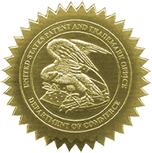
Systems and Methods for Making Jury Selection Determinations
United States 6,607,389
Issued August 19, 2003
This U.S. Patent covers research methods designed to improve jury selection determinations and strategic decisions at trial. More specifically, this method provides trial attorneys with real-life experience in voir dire and jury selection and generates research data and analytic tools designed to assist counsel in making more accurate decisions at trial.
Here is how our method works and why it is important:
An initial pool of mock jurors is assembled, given preliminary instructions and questioned in the same manner that the actual jury pool will be questioned. When questioning has been completed, attorneys for each side are permitted strikes for cause and a predetermined number of peremptory challenges. In this way, a probable jury, comprised of those in the pool who were not struck, and a stricken jury, comprised of those who were struck, are assembled. Both probable and struck groups then hear a summary of the case and deliberate the issues to a verdict. Probable Juries, because they are comprised of individuals like those who will make it onto the actual jury, generate more realistic deliberations and more accurate verdicts than conventional, randomly selected mock juries. Struck Juries, typically comprised of the worst jurors for both sides, produce intense debate, which is important for understanding jurors’ hierarchy of case issues.
Both probable and struck groups inform our jury selection strategy: The probable juries tell us who was missed who should have been struck, and the struck Juries tell us who was struck who should have remained on the panel. We then carefully analyze the strikes that were effective and those that were not and determine what we need to do better. In this way, both the probable and the struck juries ensure that mistakes during jury selection, one of the primary reasons for adverse verdicts, are minimized. LitStrat is the only firm in the country with a license for this method.

United States 7,284,985
Issued October 23, 2007
This patent covers computerized methods for conducting jury selection training. Based on this patent, we developed the only jury selection simulation program in the country. Strike Force allows the user to review case materials and juror questionnaires, and oral voir dire in preparation for the selection process. Multiple users can compete against each another or a single user can compete against the computer.

Systems and Methods for Conducting Jury Research and Training for Estimating Punitive Damages
United States 7,665,993
Issued February 23, 2010
This patent covers our methodology for accurately estimating the probability and amount of punitive damages. Until this innovation, standard methodology in the study of punitive damages called for assembling a group of mock jurors and asking them to assume liability before presenting a summary of the punitive damages case. This procedure ignores the critical process that an actual jury goes through in coming to the decision that punitive damages are warranted, a process that often includes the development of personal antagonisms, compromises, and hardened positions that can substantially impact the damage award.
Our novel method increases the accuracy of punitive damages predictions by using mock juries that have completed the liability phase of the mock trial and have found the defendant liable. The process by which a jury finds a defendant liable changes the nature and dynamic of the jury in a fundamental manner. Our method takes the totality of that experience into account, including the perceptions, coalitions, and feuds that develop during liability deliberations.
The method includes assembling a pool of jurors, presenting the liability case, and then seeing which of the juries find for the plaintiff. The damages case is then presented only to juries that found for the plaintiff, after which they deliberate in order to reach a decision on the amount of punitive damages.